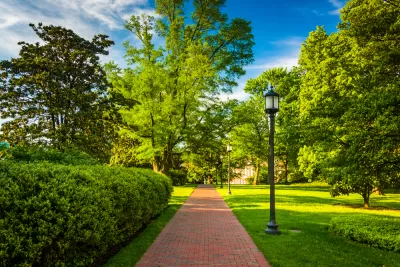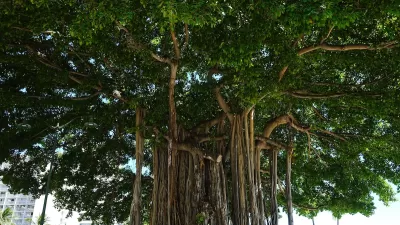The U.S. Forest Service has continued to refine the valuable i-Tree software program, which allows cities to calculate the benefits, in dollar figures, of the urban forest.

Laura Bliss reports on the work of David Nowak, a lead researcher at the U.S. Forest Service’s Northern Research Station in Syracuse, New York, and one of the founding developers of the Forest Service's i-Tree software programs.
The i-Tree system uses GIS and a complex set of algorithms, to provide "detailed inventories of their urban canopies, and calculate their dollar value." Bliss details how the i-Tree program worked for a study of Austin's urban forest in 2014 [pdf]:
A recent i-Tree analysis of Austin, Texas, led by Nowak, estimated that trees save that city nearly $19 million annually in reduced building-energy use, some $5 million in reduced carbon emissions, and account for about $16 billion as standalone physical assets. Past that, they’re worth $3 million per year in their reduction of air pollution (based on avoided respiratory health problems), and nearly $12 million per year in the amount of carbon they sequester.
The i-Tree system has been collecting new metrics since it was first released in 2006, but Nowak is still working to add more ways to quantify the benefits of trees. "Right now, some of Nowak’s work is focused on calculating the dollar value of the reduced air temperatures and absorbed UV radiation that trees provide," according to Bliss.
The article includes more about the additional potential for the i-Tree program, as well as additional findings the program has revealed about urban forests around the country.
FULL STORY: What Are Trees Worth to Cities?

Alabama: Trump Terminates Settlements for Black Communities Harmed By Raw Sewage
Trump deemed the landmark civil rights agreement “illegal DEI and environmental justice policy.”

Study: Maui’s Plan to Convert Vacation Rentals to Long-Term Housing Could Cause Nearly $1 Billion Economic Loss
The plan would reduce visitor accommodation by 25% resulting in 1,900 jobs lost.

Why Should We Subsidize Public Transportation?
Many public transit agencies face financial stress due to rising costs, declining fare revenue, and declining subsidies. Transit advocates must provide a strong business case for increasing public transit funding.

Wind Energy on the Rise Despite Federal Policy Reversal
The Trump administration is revoking federal support for renewable energy, but demand for new projects continues unabated.

Passengers Flock to Caltrain After Electrification
The new electric trains are running faster and more reliably, leading to strong ridership growth on the Bay Area rail system.

Texas Churches Rally Behind ‘Yes in God’s Back Yard’ Legislation
Religious leaders want the state to reduce zoning regulations to streamline leasing church-owned land to housing developers.
Urban Design for Planners 1: Software Tools
This six-course series explores essential urban design concepts using open source software and equips planners with the tools they need to participate fully in the urban design process.
Planning for Universal Design
Learn the tools for implementing Universal Design in planning regulations.
Caltrans
Smith Gee Studio
Institute for Housing and Urban Development Studies (IHS)
City of Grandview
Harvard GSD Executive Education
Toledo-Lucas County Plan Commissions
Salt Lake City
NYU Wagner Graduate School of Public Service





























